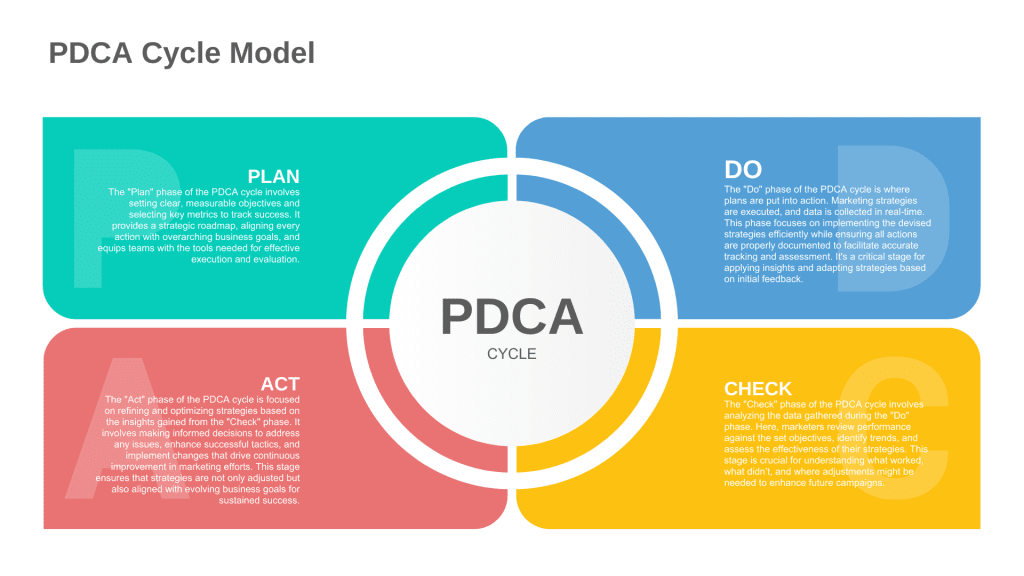Why PDCA in Digital Marketing?
In the dynamic world of digital marketing, staying ahead means continuously refining your strategies to match the ever-changing landscape. This is where the PDCA (Plan-Do-Check-Act) cycle, a systematic framework borrowed from quality management, becomes invaluable. Originally developed by Dr. William Edwards Deming, the PDCA cycle is a powerful tool for implementing continuous improvement in any process, including digital marketing.

Why PDCA is Particularly Relevant to Digital Marketing
Digital platforms are constantly evolving, highly measurable, and extremely reactive to consumer behavior. By applying the PDCA cycle, marketers can ensure they keep pace with these changes and leverage them to gain competitive advantages.
This article aims to demystify the PDCA cycle for those new to its concepts and show how it can be seamlessly integrated into digital marketing efforts. We’ll explore how to set practical goals and track relevant metrics in the planning phase, document and implement actions in the execution phase, utilize collected data to assess performance, and refine strategies to optimize results. Whether you’re a seasoned marketer or just starting, understanding and using the PDCA cycle can significantly enhance your marketing outcomes by making your processes more efficient and responsive. Let’s dive in and discover how to simplify success in digital marketing with the PDCA cycle!
Key Takeaways:
- Continuous Improvement: The PDCA cycle facilitates ongoing refinement of marketing strategies to adapt to digital trends and consumer behaviors.
- Strategic Framework: It offers a structured approach to planning, executing, reviewing, and enhancing marketing actions, making it ideal for the fluid digital marketing environment.
- Data-Driven Decisions: Emphasizes the importance of data in making informed decisions, ensuring that real-world insights guide strategies.
- Adaptability and Learning: This encourages a culture of learning and adaptability, which is crucial in a dynamic field like digital marketing.
Section 1: Planning – Laying the Foundations with Data
As in any strategic field, success begins with thorough planning in digital marketing. The ‘Plan’ phase of the PDCA cycle is where you set the stage for measurable results. This initial step involves setting clear objectives, selecting appropriate metrics, and choosing the right tools to track and analyze those metrics. Here’s how to approach the planning phase effectively:
Identify Objectives
Start by defining what you hope to achieve with your digital marketing efforts. Objectives should be SMART: Specific, Measurable, Achievable, Relevant, and Time-bound. Whether increasing website traffic by 30% within six months or boosting lead conversions by 20% in the next quarter, clear goals will guide your strategy and help quantify your success.
Select Key Metrics
Once your objectives are set, choose metrics that directly reflect your goals. These could include:
- Conversion Rates: Tracks the percentage of visitors who complete a desired action on your website.
- Engagement Rates: Measures interactions on social media posts to evaluate content effectiveness.
- Click-Through Rates (CTR): This gauges how effectively ads and emails prompt users to visit your landing page.
- Cost Per Acquisition (CPA): Calculates the cost to acquire a customer, helping assess the financial efficiency of your campaigns.
Each metric should provide insight into how well your actions align with your objectives, allowing for precise adjustments in later phases.
Tools and Resources
Choosing the right tools is crucial for efficiently tracking the selected metrics. For those new to digital marketing, here are a few user-friendly tools that can significantly simplify data collection and analysis:
- Google Analytics: A versatile tool for tracking website traffic, user behavior, and conversion metrics.
- Brand24: Great for monitoring social media and web mentions to gauge brand presence and engagement.
- Pipedrive: Useful for managing leads and sales pipelines, helping track the effectiveness of your sales strategies.
- Planable: Facilitates the planning, collaboration, and approval of social media content, streamlining workflow and execution.
- SEMrush provides comprehensive SEO, content, social media, and competitive research tools, which are invaluable for enhancing digital marketing strategies.
Documenting Your Plan
The final step in the planning phase is documenting your strategy. This documentation should include your objectives, chosen metrics, the rationale behind each choice, and the tools you will use. A well-documented plan serves as a guide throughout the rest of the PDCA cycle. It helps maintain clarity and focus, ensuring every team member understands the goals and methods.
By carefully setting up your objectives, selecting the right metrics, and establishing robust tracking methods, you prepare your digital marketing efforts for measurable success. This foundational work is critical for informed decision-making in the subsequent phases of the PDCA cycle.
Failure to Plan is Planning to Fail
Section 2: Doing – Implementing Actions and Gathering Data
Once you’ve established a solid plan, the ‘Do’ phase of the PDCA cycle involves putting those plans into action and initiating data collection. This stage is critical as it directly impacts the effectiveness of your digital marketing strategy through real-world application. Here’s how to manage the ‘Do’ phase effectively:
Execution of Marketing Strategies
Begin by implementing the marketing strategies outlined in your planning phase. Whether launching a new ad campaign, rolling out a social media strategy, or optimizing SEO on your website, ensure each action is aligned with your objectives. Key steps include:
- Follow the Plan: Adhere strictly to the timelines and budget constraints to keep your campaign on track.
- Stay Flexible: Be ready to make minor adjustments based on real-time feedback and initial results.
Documenting Actions
Detailed documentation is crucial during the ‘Do’ phase. It provides a record of what was done and serves as a reference for analyzing the effectiveness of different strategies. Key aspects to document include:
- What actions were performed: Detail every task, from social media posts to email marketing sends.
- Who performed each action: Assign responsibility to ensure accountability and clarity in your team.
- When each action was taken: Record date and time stamps to track the timing and frequency of actions.
This comprehensive documentation is invaluable for the next phase, where these actions are analyzed to determine if they achieved the desired outcomes.
Data Collection
Simultaneously, when executing actions, begin collecting data relevant to the key metrics you identified during the planning phase. Utilize the tools selected earlier to gather this information efficiently.
Ensure the data collected is accurate, timely, and relevant, providing a clear picture of the immediate impacts of your marketing efforts.
Regular Monitoring and Adjustment
While the ‘Do’ phase is predominantly about action, monitoring these actions regularly and making necessary adjustments is also critical. This approach allows you to:
- Catch Issues Early: Identify potential problems or underperforming strategies quickly.
- Tweak Strategies as Needed: Adjust tactics in real-time to optimize performance and stay aligned with your objectives.
By effectively managing the ‘Do’ phase, you implement your planned actions and gather crucial data that feeds into the following stages of the PDCA cycle. This stage sets the tone for a responsive and data-driven approach in digital marketing efforts, ensuring that every action is measured and contributes to the overall objectives. This phase is about making your plan work in the real world, learning from the initial results, and preparing for the in-depth analysis in the ‘Check’ phase.

Section 3: Checking – Analyzing the Results
After executing your marketing strategies and collecting data, the ‘Check’ phase of the PDCA cycle involves a critical evaluation of your actions against the planned objectives. This stage is all about analyzing the data you’ve gathered to assess the effectiveness of your implemented strategies. Here’s how to navigate the ‘Check’ phase effectively, with a focus on interpreting marketing signals and taking informed actions:
Reviewing the Data
Begin by compiling and organizing the data collected during the ‘Do’ phase. This step involves extracting insights from the raw data to understand how well your actions have performed against your goals:
- Compare Results to Objectives: Look at your key metrics such as conversion rates, engagement rates, click-through rates, etc., and compare these figures to your objectives. This comparison will show whether your strategies are on track or need adjustments.
- Analyze Trends: Identify trends over the duration of the campaign. For instance, note if there was a spike in web traffic following a particular marketing push or a drop in engagement after changes to content strategy.
Understanding Marketing Signals
Marketing signals are the actionable insights you can extract from your data. They indicate the health of your marketing efforts and guide future strategies. Here’s how to interpret these signals:
- Identify Patterns: Look for patterns that correlate with peaks in performance. For example, a surge in traffic from a social media campaign indicates effective channel engagement.
- Notice Anomalies: Spot any deviations from expected patterns, such as a sudden drop in email open rates, which could signal issues with email content or delivery times.
Examples and Actions Based on Marketing Signals
- High Engagement Posts: If certain types of content consistently generate high engagement, consider focusing more resources on these topics or formats. For example, if video content on social media drives more interaction than other types, prioritize video production.
- Low Conversion Rates: If a campaign has high traffic but low conversion rates, investigate potential issues in the user experience or the offer itself. A/B testing different landing page designs could provide insights and improve conversions.
Visualizing Success and Setbacks
To make the data more accessible and understandable, use visual aids:
- Charts and Graphs: Utilize tools like Google Analytics to create visual representations of data trends and performances. Graphs can help depict changes over time, while pie charts can show traffic sources or engagement types.
- Dashboards: Viewing multiple data points at once helps get a holistic view of your campaign’s performance.
Learning from Data
The essence of the ‘Check’ phase is to draw actionable insights from the data:
- Successes: Highlight strategies that were effective and explore why they worked well.
- Challenges: Acknowledge areas that did not perform as expected. Delve into possible reasons for these setbacks—was it the execution, external factors, or misalignment with audience preferences?
- Feedback Collection: If applicable, gather feedback directly from your audience through surveys or feedback forms. This direct input can provide additional insights into how your actions were perceived.
Documentation of Findings
Document your analyses comprehensively. This documentation should include:
- Data Interpretations: Record your findings and interpretations of the data.
- Visuals and Graphs: Include copies of charts and graphs that you used for analysis.
- Feedback Insights: If feedback was collected, summarize the key points and how they relate to your data findings.
The ‘Check’ phase is crucial for learning from the implemented actions and preparing for the final phase of the PDCA cycle. It provides a reality check against your expectations and serves as a basis for continuous improvement in your digital marketing strategies. By thoroughly analyzing your data, you can make informed decisions about future marketing efforts, ensuring they are even more aligned with your business objectives.
Section 4: Acting – Making Informed Decisions
Following the thorough analysis conducted in the ‘Check’ phase, where you identified marketing signals and interpreted data trends, the ‘Act’ phase of the PDCA cycle focuses on applying these insights to enhance your marketing strategies. This final stage is about making informed decisions to optimize and refine your marketing efforts based on the results from the previous phase. Here’s how to navigate the ‘Act’ phase effectively, with a focus on translating analysis into action:
Utilizing Insights for Improvement
Start by revisiting the key findings and marketing signals identified in the ‘Check’ phase. Use these insights to guide your decisions for improvements:
- Incorporate Successful Elements: Based on successful outcomes, such as high engagement on specific types of content or effective ad placements, plan to replicate these strategies in future campaigns.
- Address Challenges: For areas that underperformed, such as low conversion rates or poor customer feedback, develop targeted actions to address these issues.
Example of Improvement Action Items
Let’s illustrate with examples how the insights from the ‘Check’ phase can translate into actionable improvement items:
- High Engagement Video Content:
- Action: Increase the production of video content similar to those that garnered high engagement.
- Implementation: Schedule a series of video content focused on popular topics, allocate budget for better production quality, and train your team on advanced video marketing techniques.
- Low Conversion Rates on Landing Pages:
- Action: Revise and A/B test different elements of the landing pages to enhance user experience and conversion rates.
- Implementation: Design A/B tests to compare different headlines, call-to-action buttons, and layout designs. Analyze the results to determine which variations perform the best and implement these changes across all landing pages.
- Feedback on Customer Service Concerns:
- Action: Address customer service issues highlighted in feedback to improve satisfaction and retention.
- Implementation: Develop a new training program for customer service representatives focused on areas needing improvement, and introduce a quicker response system to enhance customer interaction.
Formulating New Strategies
With improvements identified and action items laid out, formulate new strategies for the next PDCA cycle:
- Set New Objectives: Based on the learnings, set revised goals that are challenging yet achievable, ensuring they align with the broader business objectives.
- Develop a Detailed Plan: Outline the steps necessary to implement the new strategies, including timelines, responsible persons, and required resources.
Establishing Feedback Loops
Create feedback loops within your organization to ensure these new strategies are effective and continuously improved:
- Regular Reviews: Schedule periodic reviews to assess the ongoing effectiveness of the implemented changes and make further adjustments as necessary.
- Stakeholder Feedback: Continually engage different departments and stakeholders in the feedback process to gain broader insights and foster interdepartmental cooperation.
Documenting Changes and Rationale
Ensure that all decisions, changes, and rationales are well-documented:
- Updated Documentation: Revise the original plan documents to reflect the changes made during the ‘Act’ phase.
- Record Outcomes: Document the outcomes of the changes once they have been implemented in the next cycle to measure their effectiveness.
By systematically applying the insights gained from the ‘Check’ phase, the ‘Act’ phase closes the loop of the PDCA cycle but also sets the stage for the next iteration. This continuous loop of planning, doing, checking, and acting not only optimizes your strategies but also embeds a culture of perpetual growth and improvement within your team. This approach ensures that your digital marketing efforts are always evolving to become more effective and aligned with your business goals.
Conclusion: Embracing Continuous Improvement in Digital Marketing
As we’ve navigated through the stages of the PDCA cycle in the context of digital marketing, it’s clear that this iterative process is invaluable for achieving sustained growth and improvement. By continuously cycling through planning, executing, checking, and acting, digital marketers can stay agile and responsive to the ever-changing digital landscape.
Key Benefits of the PDCA Cycle
- Adaptability: The PDCA cycle empowers marketers to quickly adapt to market changes and consumer behaviors, ensuring strategies remain relevant and effective.
- Data-Driven Decisions: This approach emphasizes the importance of data in guiding marketing decisions, allowing teams to pivot based on solid evidence rather than assumptions.
- Enhanced Collaboration: Regular feedback loops and documentation foster a collaborative environment where every team member is aligned and informed.
Encouraging Continual Learning and Adaptation
To truly benefit from the PDCA cycle, it’s essential to foster a culture of learning and flexibility within your marketing team. Encourage ongoing education, experimentation, and openness to change. Each cycle should not only aim to meet set objectives but also to uncover deeper insights and innovative ways to engage customers.
Starting Simple and Scaling Up
While the process of implementing the PDCA cycle might seem complex or tedious, it’s adaptable to any organization. Start with something simple, such as a single marketing campaign or a specific aspect of your digital strategy. This allows you to grow your approach organically, scaling up as your team becomes more familiar with the process and sees its benefits firsthand.
Aligning with Team Skills and Knowledge
It’s crucial to implement the PDCA cycle at a level that matches your team’s current skills and knowledge. This ensures that the process is manageable and effective, allowing your team to truly understand and leverage the PDCA methodology for better results.
Start Your First Step
Begin with one marketing campaign to apply the PDCA cycle and observe its benefits in action. Document each stage, learn from the outcomes, and gradually expand the approach to encompass more of your marketing efforts. Over time, this continuous loop of improvement will not only enhance your marketing strategies but also drive meaningful growth for your business.
In conclusion, the PDCA cycle isn’t just a methodology; it’s a mindset. By embedding this cycle into your marketing practices, you prepare your team for sustained success and innovation in a field where change is the only constant.



